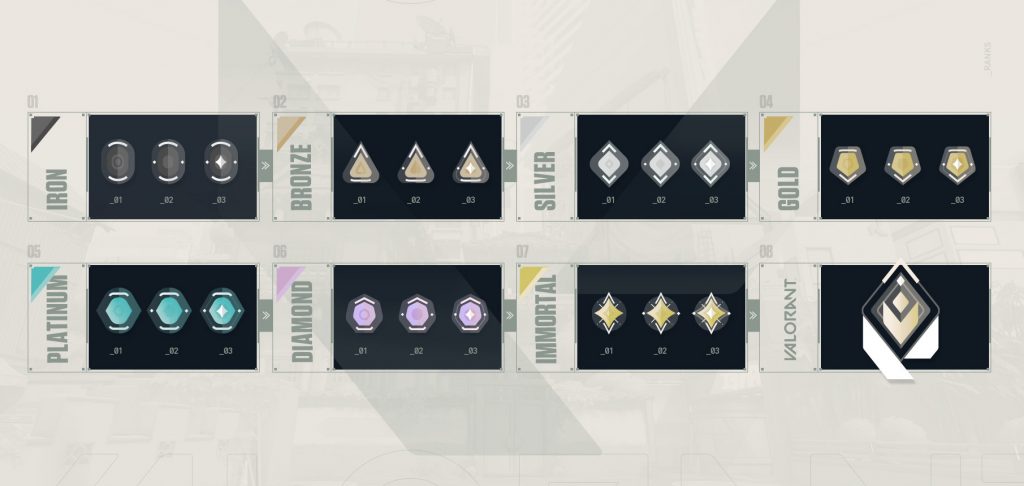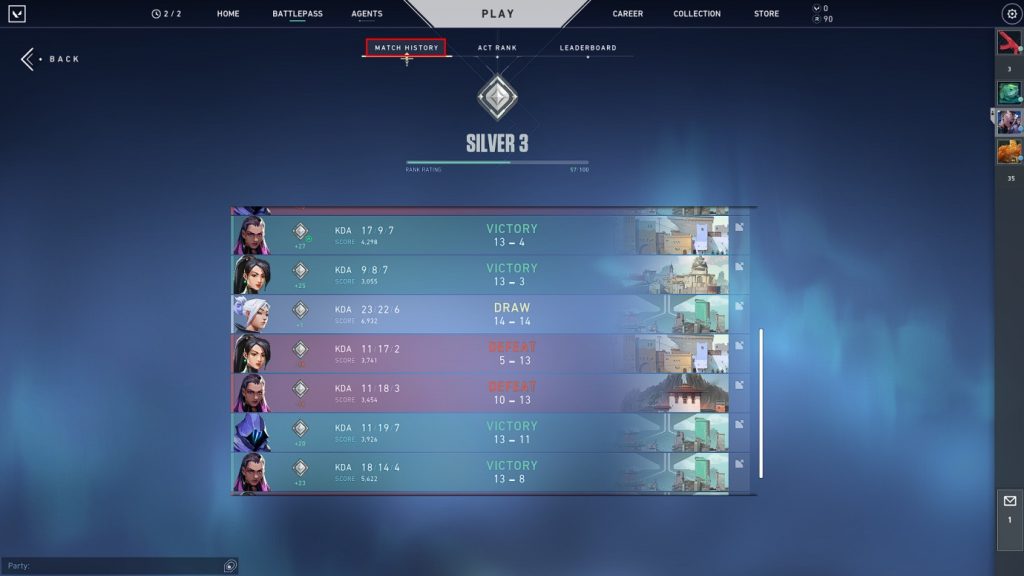Valorant brings very crafted gameplay with a close similar shooting mechanic to CSGO whilst adding more technical ability which is considered to be an advanced version of utility in the round. Where it differentiates itself is in the individual characters’ abilities, which create a robust range of outcomes, and make the game more interesting through an additional layer of unpredictability.
If you’re a fan of first-person shooter games and have a competitive streak as wide as the Missouri River, you’ll love Riot Games’ new competitive rank mode—a character-based 5v5 tactical shooter game that’s even better now than it was when it first launched. To get started, arm yourself with the game’s ranking system knowledge.
You can continue navigating to learn more about how the Valorant ranking system works, how the ranks progress, and how the game functions with ranking.
Table of Contents
How Does Valorant Ranking System Works?
If you are new to the game Valorant Rank might be a bit confusing. Like any other multiplayer competitive game, Valorant also has ranking systems. To start, you have to complete 10 unrated matches and win them to jump into competitive/ranked mode which was previously 20 unrated matches.
Once you have won 10 unrated matches, you will have to complete five placement matches. These matches will determine where you should start in the game’s ranking system. Don’t stress about placement matches. Even if you lose your matches, the game still takes into account your performance. Your last 10 unrated wins will be also taken into account when determining your rank.
How Many Total Ranks & Tiers Are In Valorant?

In all, there are eight ranks/divisions in the Valorant ranking system. The first six ranks also have three sub-ranks and each one you need to obtain to advance to the next rank. The last two ranks, Immortal and Radiant, each have only one level. So, Valorant has a total of 20 ranks, excluding the unranked ones.
- Iron
- Bronze
- Silver
- Gold
- Platinum
- Diamond
- Immortal
- Radiant (previously called “Valorant”)
Most players start with the Iron Rank, although their performance during placement matches can place them at a higher ranking and level. For example, exceptional players can skip level four and see their starting rank at Bronze 2. It’s also possible to skip ranks and levels when you compete in Competitive Mode. It all depends on your MMR or matchmaking rating, performance and frags in the match. Consistency is key if you keep an eye on falling down the ranks. Go on big winning streaks, get some MVP, and you can move up through the ranks faster.
It takes a lot of dedication and patience, but if you perform well and win matches, you can eventually make your way to the top of the leaderboard. The top two ranks in the gallantry system are reserved for the best of the best. Only 500 players per region will receive the Radiant Rank while the Immortal Rank is reserved for the top 1% in each region.
Does Player’s Valorant Ranking Decay?
Unlike other online multiplayer games, Valorant does not have a rank decay mechanism. This means you can take a break from playing when needed. However, you cannot walk away from the game for a long time. If you do, you’ll have to play a placement game to restore your rank. The placement game helps determine your skill level after a long absence and whether you can still compete at your final rank.
In fact, it makes sense from a competition standpoint. Riot Games wants to make sure that you will be placed in matches that are appropriate for your skill level. It can also help you finish the placement game before things get back into swing. The last thing you want is to revert to competitive mode only to find that you’re a little tough and in over your head.
Note: Valorant can run on Potato PC, a low-end PC can run the game smoothly, with no issues at all. Check out the minimum and recommended requirements.
Regional Leaderboards

As of the newest update (Episode 2), Valorant players can view the regional leaderboards to discover how they stack up against other players in their area. To use this feature, open your profile from the main menu and select ‘Competitive’. From here you will be able to see your rank and rank rating as well as some personal information about yourself such as your Riot ID, player card and Summoner name.
If you wish to remain anonymous when competing against other players, you may choose to change this information from your ‘Profile’ tab. However, once you have played at least 50 games there will be no need for anonymity – these statistics will be available for anyone to see. To maintain your position on the leaderboard, make sure that you play at least one competitive match per week so that your rank will not decay too quickly.
Checking Past Match History
Getting insight into your past matches can help you determine what you’re doing right and where it’s all going wrong as you climb the ranks.

To access your match history, go to the game’s main dashboard and then press the Career tab located at the top of the screen. Check out the information for your last 10 matches by selecting any one of them and looking at the details.
You’ll be able to see stats like kills, spike plants, assists, and first blood, along with wins and losses. If you’re the type of player who likes to get a little meta, this information is invaluable for understanding and optimizing your match performance. As a bonus, you can also see how other players performed in the same match. Just choose a game and see the details.
What Is Match Making Rating (MMR)?
Matchmaking rating, or MMR, is a hidden number that determines your matchups with other players in competitive mode. It works like a giant ladder: you start at the bottom rung, and your goal is to reach the top. Each game that you play helps you get closer to the top, or it might knock you down a few notches if you’re playing against tougher opponents. It’s just a rating that helps the game match you to players of the same level, and it’s different from your RR or rank rating.
What Is Rank Rating (RR)?
Your rank rating is the number of points you get after each competitive game. You earn RR points based on competition wins and your overall performance in the match, especially in the lower levels. To proceed to the next level, you need to accumulate 100 RR points. Point allocation varies from game to game, but generally, the distribution looks like this:
- Wins: 10 – 50 RR, 5+ RR for Diamond ranks and above
- Losses: Minus 0 – 30 RR, 50 RR max drop for Diamond ranks and above
- Draws: 20 RR (based on performance) for ranks Iron – Diamond
Be careful though, because if you don’t get any RR points in the game, it’s possible to be demoted to the previous level. If you get demoted, Valorant has “demotion protection” for players in that you won’t drop below 80RR for the newly demoted rank. The good news is that it will only take you 20 RRs to get back to the previous rank, but the bad news is that you got demoted to the first place.
How MMR Is Different From RR?
Valorant has a different scoring pattern so your MMR and RR are different. One helps match the game to suitable players while the other determines your performance rank for the competitive mode.
Here’s where it gets a little confusing:
As we know, Riot Games strives to create fair matches that are suitable for our skills. They use our Matchmaking Rating (MMR) to decide how well we will do in a game. By looking at both your Matchmaking Rating and Rank Rating, they decide where you should start out in your rank. If you can improve and prove how good you are, the system will match your MMR with people who are close to your performance level. So if you win a lot of games or get a lot of points in Ranked, you’ll move up on the ladder. And if you lose a lot of games, you’ll move down. Ultimately, Riot Games wants all players to “converge” for their MMR and RR scores. Ideally, your Ranked rating will reflect your performance level and your MMR will allow you to prove that you belong to that rank.
Play Quality Games To Climb the Ranks
Although it might be tempting to play as many games as possible, you should play with a strategy that is effective and efficient. When you win a match in the online Ranked Mode, the game weighs your performance based on several parameters. If you want to improve your ranking and make it to the top of the leaderboard, pay attention to quality over quantity.
How long does it take you to progress from rank to rank in Valorant’s Rank Mode? Share your thoughts in the comment section below.

